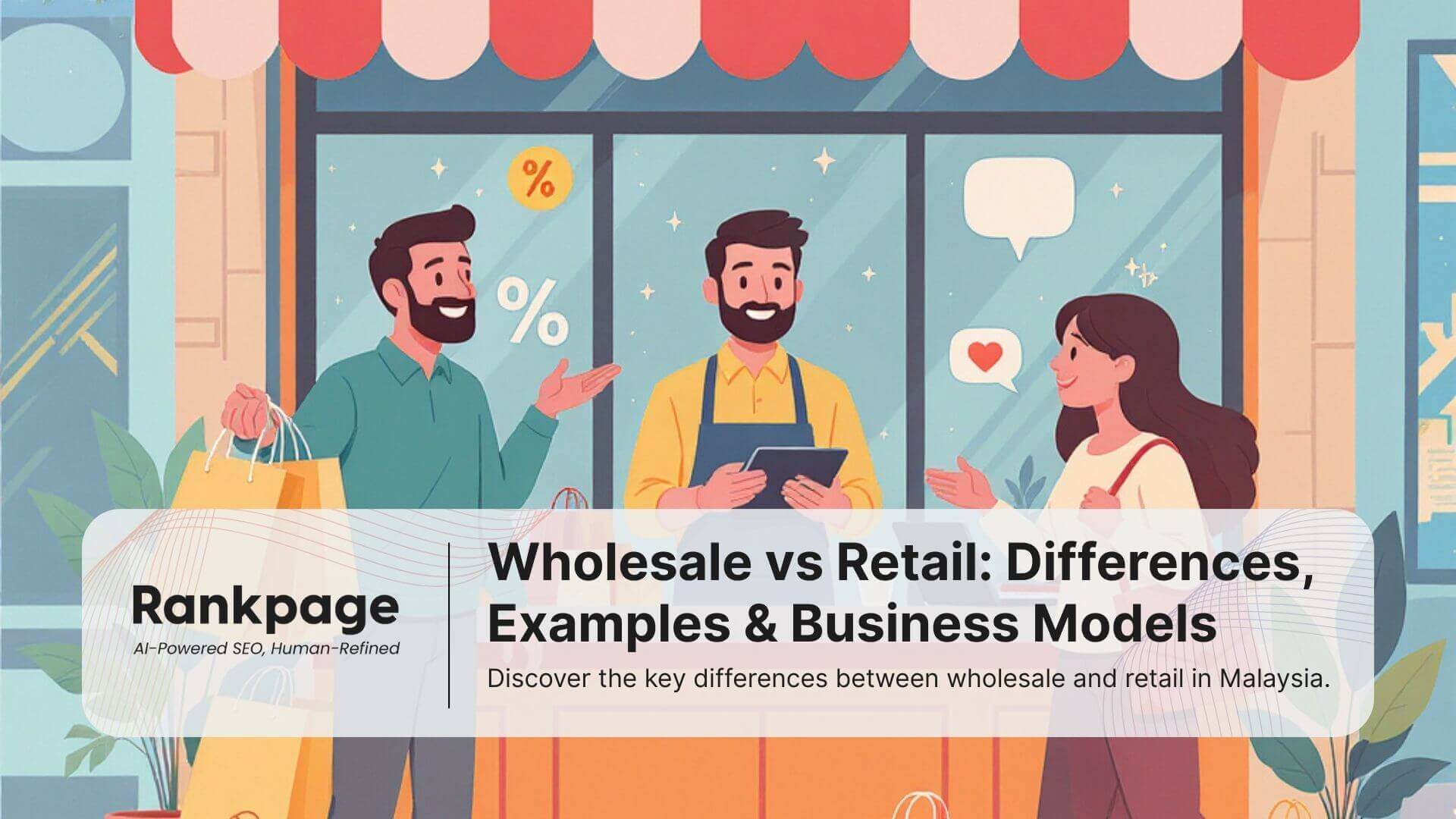Key Takeaways
- Retail targets end-users, wholesale serves businesses, this core difference shapes margins, operations, and growth potential.
- Retail suits low-capital, brand-focused strategies, while wholesale favours volume, supply-chain access, and higher upfront investment.
- Hybrid models are growing in Malaysia, as SMEs blend B2C retail with B2B supply through platforms like Shopee, TikTok Shop, and Borong.
- Licensing, capital, and logistics differ, all businesses register with SSM, but foreign-owned distributors may also require WRT licences.
- Malaysia’s wholesale & retail trade hit RM148.3b in Feb 2025, showing strong demand and opportunities across both models.
Wholesale involves selling goods in bulk to businesses, while retail sells directly to end-consumers in smaller quantities, both are valid models with distinct advantages.
You’ve probably heard this advice before: “Go start a business.” But no one tells you what kind. Should you open a kedai runcit or supply stock to twenty of them?
In Malaysia’s evolving market, choosing between wholesale and retail is more than a business model, it’s a strategic fork in the road with many head scratching or Google search.
Today, we will break down the differences between wholesale and retail and help you decide which suits your business goals.
Table of Contents
What Is Wholesale in Malaysia?
Instead of targeting the public, wholesalers focus on supplying inventory to downstream retailers, pharmacies, F&B outlets, and even online stores. They deal in volume, as in the truckload of cartons, pallets, or full-container loads, not single items.
Wholesalers typically operate from warehouses or distribution centres, rather than consumer-facing retail outlets. Many even skip physical stores entirely and transact through B2B marketplaces or WhatsApp ordering.
Examples of Wholesalers:
- NSK Trade City: Bulk groceries and sundries
- Keong Heng: toys, stationery, gifts
- Selangor Wholesale Market: Wet market goods
- Borong (formerly Dropee): Digital wholesale platform for brands and SMEs
Key Characteristics of Wholesale:
- Business-to-business (B2B) focus
- Large order volumes at lower price per unit
- Thin profit margins, but scalable with volume
- Logistics-driven, not branding-led
- Requires larger upfront capital to purchase stock
“Wholesale is a supply chain game: scale wins, branding is secondary.”
If you’re more comfortable with warehouse operations, supplier negotiations, and managing stock levels rather than customer-facing branding, wholesale might be your lane.
What Is Retail in Malaysia?
Retailers are the final touchpoint in the supply chain. Unlike wholesalers, they directly interact with end-users. This means more focus on customer experience, store presentation, and emotional connection to the product or brand.
In Malaysia, retail is basically everywhere. From 99 Speedmart to Mr DIY stores, and Shopee storefronts. Whether offline or online, retailers win when they make buying feel effortless, enjoyable, and trustworthy.
Examples of Retailers:
- Watsons: Personal care & pharmacy
- Tealive: Beverages (franchise retail)
- Mr DIY: Home improvement (high-volume chain)
- Hermo: Beauty products (online-only)
- FamilyMart: Convenience retail with dine-in concept
Key Characteristics of Retail:
- Direct-to-consumer (B2C) model
- Lower purchase quantity per transaction
- Higher margin per unit sold
- Heavily marketing-driven (branding, UX, promotions)
- Lower capital barrier to entry (especially for online or micro-retail)
If you enjoy customer interaction, storytelling, and building a recognisable brand, retail gives you more control over how people experience your business.
Retail vs Wholesale: What Are the Key Differences?
| Factor | Retail | Wholesale |
| Customers | End-users | Other businesses |
| Order Volume | Small | Bulk |
| Profit Margin | Higher | Lower |
| Price per Unit | Higher | Lower |
| Marketing Focus | Branding, UX | Relationship-building |
| Licensing Requirements | Basic SSM registration, some permits | May require wholesale import/export permits |
| Capital Needs | Lower | Higher |
| Technology | POS systems, eWallets | Inventory software, B2B portals |
As technology and supply chain improves, the line between the two is blurring, retailers now buy from B2B marketplaces, and wholesalers run Shopee stores.
Which Model Fits Your Business in Malaysia?
Retail is best for founders with smaller capital but strong branding, while wholesale suits supply-driven businesses with scale, capital, and storage capacity.
But really, the model you choose defines how you make money, who you sell to, and how fast you can grow. And in Malaysia, that choice also depends on things like licensing, supplier networks, market trends, and even location.
Let’s break it down clearly.
Choose Retail If You:
You’re brand-first, cost-conscious, and customer-focused.
Retail makes sense when:
- You want to build a recognisable brand (fashion label, skincare line, food kiosk)
- You prefer direct customer relationships, online or in-store
- You’re operating with limited inventory (dropshipping, pre-order models)
- You want to leverage e-wallet trends (GrabPay, TNG, DuitNow QR)
- You’re taking advantage of low-cost TikTok marketing or Shopee traffic
- You’re planning to apply for Madani digitalisation grants to set up POS, CRM, or eCommerce tools
Example: A local perfume brand selling via Shopee, Instagram, and pop-up booths with RM5,000 startup capital.
Source: BNM Annual Report 2023, Payments: QR/e-payment adoption framework. (Mar 20, 2024)
Choose Wholesale If You:
You’re supply-first, logistics-ready, and focused on scale.
Wholesale is ideal when:
- You have access to low-cost inventory or act as an importer
- You aim to supply to kedai runcit, pharmacy chains, or eCommerce sellers
- You can fulfil larger orders efficiently (via warehouse, stockist, or 3PLs)
- You’re already in distribution or manufacturing (beverages, FMCG, auto parts)
- You’re ready to list on B2B platforms like Dropee or Alibaba Malaysia
- You’re comfortable working behind the scenes, not dealing with end-users
Example: A stationery importer supplying RM1,000 minimum orders to 80 school bookstores across 6 states.
Or Go Hybrid: The Best of Both Models
Many Malaysian businesses are now blending both.
This is especially true for brands with strong supply + brand identity, who:
- Sell wholesale to resellers or dealers
- Run D2C retail via Shopee, TikTok, or their own website
- Maintain different pricing tiers and logistics workflows for each segment
Case in Point: Signature Market sells retail to health-conscious buyers online, while also supplying bulk to gyms, cafés, and retailers.
The TLDR?
If you’re just starting, retail offers faster market testing and brand control with lower risk.
If you’ve got access to stock, space, or supplier deals, wholesale delivers higher volume and long-term scalability.
What Are the Current Retail & Wholesale Trends in Malaysia?
Retail and wholesale models are merging in unexpected ways as AI tools, platforms, and customer habits evolve across Malaysia. And it’s important to keep up with the times too, adapting to technology shifts is what keeps a business agile and flexible.
1. Retailers Are Embracing Cashless and Cloud Systems
POS, e-wallets, and online-first storefronts are a familiar sight across counters, cashless payments are everywhere.
- Mobile e-wallet payments such as DuitNow and Touch ‘n Go are increasingly common, and adoption is expanding across SMEs, including small retailers and pasar malam vendors.
- Small retailers are adopting POS systems with cloud-based inventory tracking
- Many new retailers launch online-first via platforms like Shopee or TikTok Shop, without opening physical outlets.
- Customer loyalty tools and reward systems are being built into mobile apps
2. Wholesalers Are Becoming More Platform-Based
Bulk suppliers are listing online, automating orders, and streamlining delivery.
- Traditional wholesalers are joining platforms like Dropee, OrderSini, or building their own storefronts
- Logistics is becoming a value-add: instant ordering, automated stock updates, partner shipping (J&T Cargo, Lalamove)
- Some wholesalers are now offering self-service pricing tiers for micro-resellers and dropshippers
In other words: Wholesale no longer needs to happen in-person at 7am in Selayang.
3. Hybrid Selling Models Are Taking Over
Businesses are blending retail and wholesale to unlock both margin, volume and of course sales.
- D2C (Direct-to-consumer) brands offer single units via TikTok Shop but bulk packs via Shopee or WhatsApp
- Retailers with strong supplier networks now sell to other resellers in their category
- Brands are segmenting their audience: full-price for end customers, tiered pricing for stockists
“We retail on Shopee, but our biggest revenue still comes from bulk orders through WhatsApp.” – David, a furniture wholesaler in Johor.
4. Business Tech Adoption Is Leveling the Playing Field
Affordable digital tools are helping even micro-SMEs scale operations.
- Retailers are investing in inventory and payment gateways systems to reduce manual tracking
- Wholesalers are digitising order flows and customer records for better fulfilment speed
- Software adoption is no longer just for big chains, it’s now common for startups and neighbourhood vendors alike with many affordable options.
Small doesn’t mean outdated. With the right tools, even a one-person business can sell like a chain.
5. Retail Chains & Mini-Wholesale Are Expanding
From 24-hour marts to bundle-based resellers, the space is growing fast.
- Multi-outlet chains like KK Mart, FamilyMart, and 99 Speedmart are blending retail with centralised buying power
- Home-based resellers are bulk buying and distributing tissue, drinks, or snacks locally
- Even online influencers are getting into the game, selling in bundles, not units
Conclusion on Retail or Wholesale: Which One Should You Start?
- Retail = faster launch, customer-focused, and marketing-led.
- Wholesale = slower scale-up, capital-intensive, but stable volume.
If you’re starting lean and want visibility fast, go retail. If you’ve got stock, space, and supplier control, go wholesale.
And if you’re ambitious? Combine both.
Choosing the right model early saves you time, compliance headaches, and costly pivots down the line.
Whether you sell to shoppers or supply to resellers, the experts at Rankpage help your business rank higher, attract traffic, and convert real customers through tailored enterprise SEO and digital strategy.
Whatever you choose, just know you have a partner in us!
FAQ About Wholesale vs Retail in Malaysia
What Is The Main Difference Between Retail And Wholesale?
Retail sells to individual consumers; wholesale sells in bulk to businesses.
Can One Business Do Both Retail And Wholesale?
Yes, many Malaysian SMEs operate hybrid models to maximise revenue.
Is Retail Or Wholesale More Profitable?
Retail has higher margins, but wholesale can be more stable at scale.
What Licenses Are Needed For Retail Vs Wholesale In Malaysia?
All companies register with SSM. Foreign-owned distributors typically require a WRT licence (KPDN). Import/export permits apply only to controlled goods.
Which Business Model Needs More Capital?
Wholesale typically requires more capital due to larger stock volume.
Are there grants for retail and wholesale businesses in Malaysia?
Yes, several government and private programmes offer support for digital tools, POS systems, eCommerce adoption, and business process upgrades for both retail and wholesale models.





